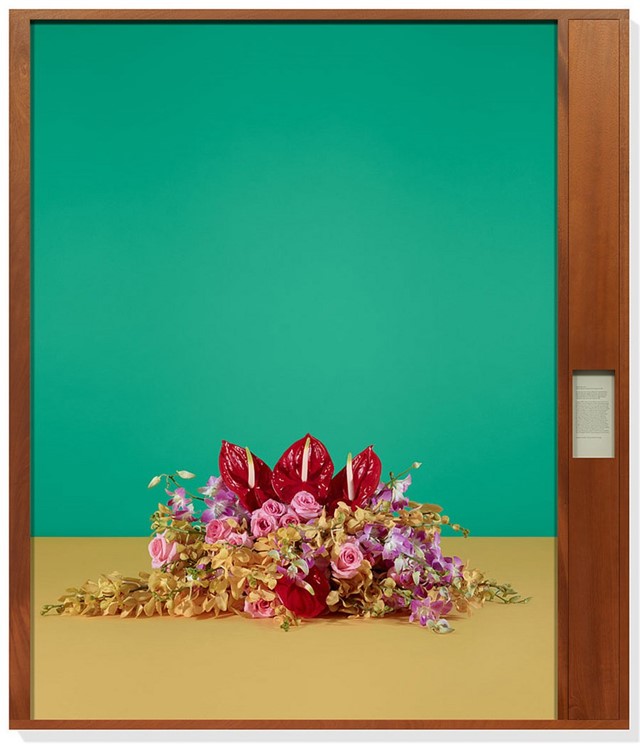In a new exhibition at New York's Gagosian, the artist examines governmental agreements through the bouquets presented to seal them
Illuminating unexamined landscapes, obfuscated hierarchy, concealed hegemony, and lapsed genealogy, American photographer Taryn Simon authors unorthodox imaged inquisitions. The artist is fascinated by tangential unity, outlier agency, and the ulterior theatres and transactions of power that arbitrate much of humanity’s everyday affairs; her interrogative images excavate, deconstruct and categorise wholly obscured objects and phenomena.
Simon’s archetypal An American Index of The Hidden and Unfamiliar (2007) systematically dissected that which remains veiled within the United States; cryopreservation, nuclear waste encapsulation, the Central Intelligence Agency’s art collection, hymenoplasty, "confronting the divide between those with and without the privilege of access". Whilst Contraband (2010), comprised of 1,075 photographs documenting those objects confiscated at the U.S. Customs and Border Protection Federal Inspection Site and the U.S. Postal Service International Mail Facility at John F. Kennedy International Airport, New York, across one working week. Birds of the West Indies (2013–14), a two-part work, draws its title from American ornithologist James Bond’s exhaustive taxonomy; the author’s name itself an appropriation by novelist Ian Fleming, an enthusiastic bird watcher, for infamous British Secret Service Agent, 007. Visually inventorying vehicles, weapons and women from across Bond films for the work’s first half, the second encompasses Simon herself as ornithologist James Bond; identifying, photographing, and classifying all birds which appear throughout the Bond franchise’s twenty-four films.
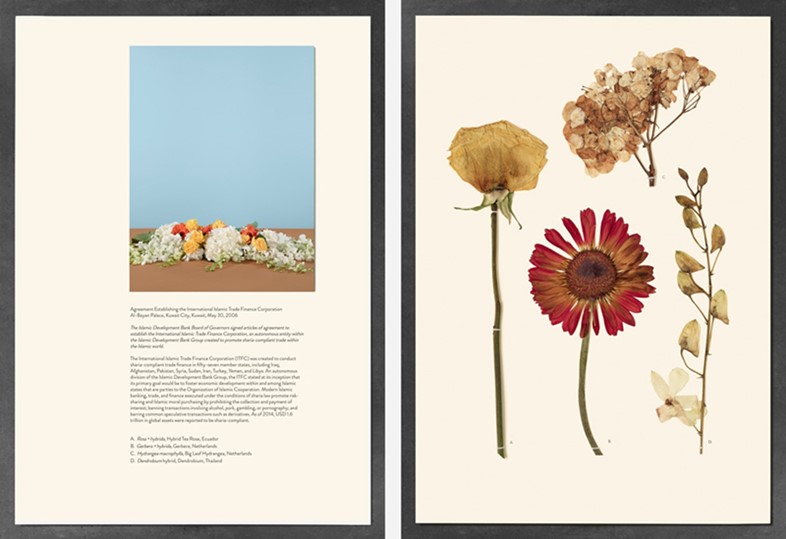
Simon’s latest offering, entitled Paperwork and the Will of Capital; An Account of Flora as Witness, "resurrects agreements, contracts, treaties, and decrees drafted to influence systems of governance and economics". Accompanying such bureaucratic ephemera with meticulous reproductions of commemorative floral arrangements that once accompanied occasions of international power-brokerage, her botanical facsimiles, recreated from archival photography, serve as illustrative microcosms, "silent observers of man’s determination to control the fates of nations, institutions, and the natural world".
Encompassing over 4,000 plant specimens sourced exclusively from the world’s largest flower auction in Aalsmeer, Netherlands, where each day approximately 20 million flowers are redistributed to the world’s flower markets, Paperwork and the Will of Capital’s verdant witnesses attest to the fragility of power’s negotiation, and the ephemerality of power’s possession. Transubstantiating such organic arrangements, through documentation, now into sculptural and archival account, these chromatic preservations serve to examine the authenticity and reliability of past narrative and chronology, as well as the endurance of allegiance and record. For just as botanical specimens, photographs and memories transform and decay with time’s unceasing passage, inescapably consigned at last to oblivion, so such a fate awaits the transitory affairs of humanity. Ahead of Paperwork and the Will of Capital’s inaugural North American exhibition, Simon reveals further thoughts for AnOther on the degradation of memory, the opaque realms of power’s brokerage, and the futility of sought posterity.
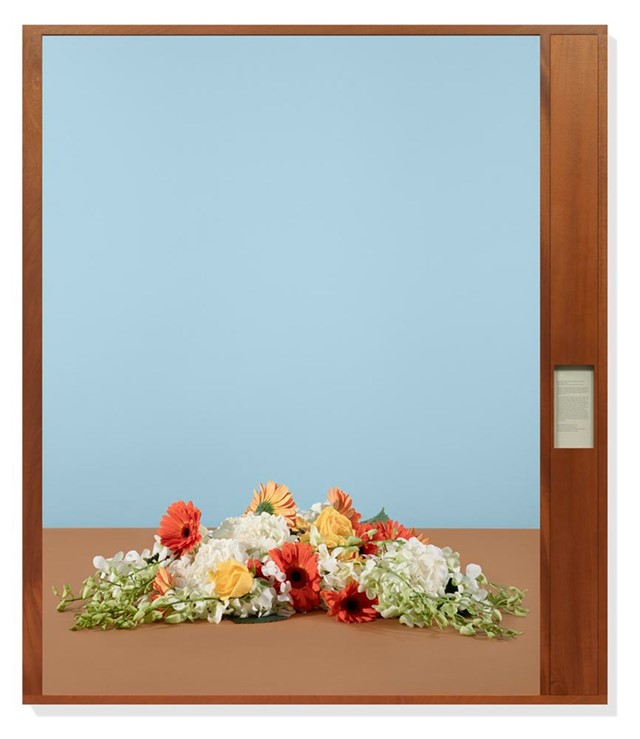
On the abstract Will Of Capital, and facilitation of such within the political economics of power-brokerage...
"The root of all the ceremonies selected as the subject of my works is economic. It was the motivating force behind whatever the surface purported to be. The works include all of the countries present at the historic 1944 United Nations Monetary and Financial Conference in Bretton Woods, New Hampshire, which addressed the globalization of economies after World War II, leading to the establishment of the International Monetary Fund (IMF) and the World Bank."
On observable patterns of inclusion, regarding botanical varieties...
"The work is in strict relation to the archival images and films of these historic signings. The pattern of men flanking elaborate bouquets has an endless history. I worked with a botanist to identify the specimens present in these recorded materials and then recreated the bouquets with specimens purchased from the world’s largest flower auction. Identifications were made from source material as opposed to the actual event, which inevitably allows for slippage – particularly when looking at a degraded and non-central element. There are notable oddities – like a meeting between Ronald Reagan and the Mujahadeen punctuated by a bouquet of succulents. I photographed the recreated bouquets against foreground and background colours selected form the décor present in the original ceremony. Some images are black and white as the source material was only available in that form."
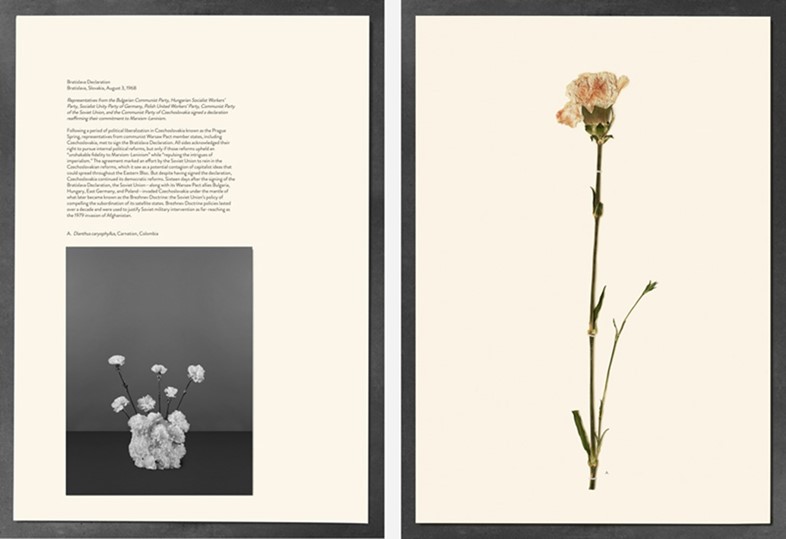
On the phenomenon of the Impossible Bouquet...
"The impossible bouquet is a 17th century phenomenon that collided with the early murmurings of capitalism in the Netherlands – the Dutch East India Company and even Tulip Mania – what is deemed the world’s first speculative bubble. These paintings were of flowers that couldn’t be together in nature at the same time and season. They represented a fantasy – one that is now possible through a global market in which consumers can get anything at anytime irrespective of nature’s limitations."
On the enduring presence of bouquets, within traditionally male-dominated realms..."
This struck me visually during my research, the role of the flowers as silent witnesses in the stagecraft of power relations that were being enacted entirely by men. My aesthetic decisions were also guided by these notions. The wall works are large and bombastic – like flags."
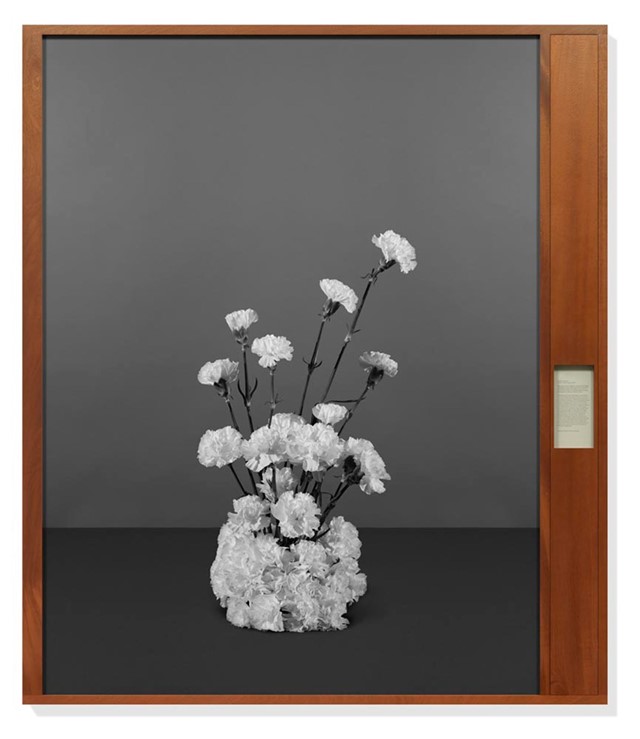
On the arrangements themselves as illustrative microcosms of the very power brokering they officiate over...
"The specimen’s behaviours both in their modified state for sale and their original state in nature do mimic that of man in the game of agreement-making. There are many crossovers – survival, proliferation, manipulation."
On attempting to lend substance to the ephemeral instances that constitute power brokering...
"Paperwork and the Will of Capital involves extensive research into the instability of executive decision-making and the precarious nature of survival, as well as the reliability and endurance of records: the accords and their far-reaching effects, my photographs, and the preserved botanical specimens. The perennially vibrant still-lifes in the photographs stand in purposeful contrast to the fading sculptural natures mortes: as time advances, so do these artefacts transform, revealing mutable and unstable versions of themselves."
Taryn Simon: Paperwork and the Will of Capital; An Account of Flora as Witness is exhibited at the Gagosian Gallery, New York, until March 26, 2016.
